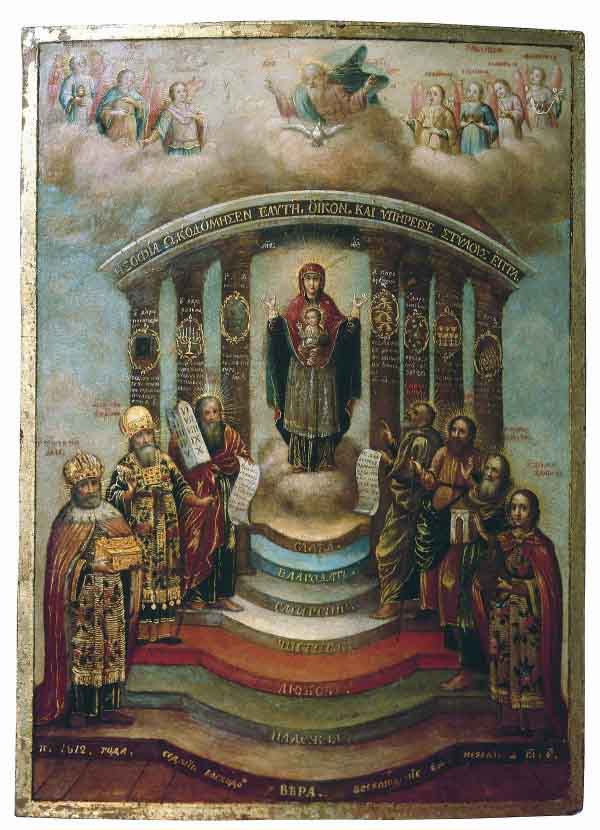The history of Western music did not begin in the baroque period. A continuous musical tradition can be traced back at least as far as the early middle ages and this music itself has links to the musical traditions of ancient Greece. Much of this music fell into relative obscurity due to its notation and the anonymity of its composers, however throughout the 20th century a concerted effort on the part of scholars and performers has resulted in a revival of much of the music of the middle-ages and the renaissance. This series will present selections of music from the middle-ages and the renaissance together with some historical and philosophical background along with reflections on why it is relevant to metalheads.
The earliest medieval music that has been preserved to the present day is monophonic, that is to say it consists of a single melodic line without a harmonic accompaniment. This music has mainly been preserved in the form of the sacred chants of both the Catholic and Orthodox churches. The chants associated with the Catholic church are relatively well known to Western ears as Gregorian chant, whereas the chants of the Orthodox church are less familiar.
From a purely technical standpoint these pieces are interesting due to their use of different modes (scales) and the fact that they focus on pure melody, rather than using melodic lines that conform to a harmonic structure. This approach will not be entirely unfamiliar to metal listeners given that death metal in particular tends to utilise melodic lines which are not rooted to a particular harmonic scheme. From an artistic standpoint these chants are also of interest to metal listeners. Their contemplative and reverent nature speaks to a mentality more aligned with metal than with modern incarnations of Christianity and suggest an understanding of that religion which has long since been forgotten.
The following is an example of Byzantine chant (the chant of the Greek Orthodox Church). Note that it utilises a vocal drone which is not entirely static but moves away from and returns to the tonic note of the mode in order to create tension and resolution. This technique may be considered a predecessor of modern harmony but the music is still essentially focused on melodic material.
https://www.youtube.com/watch?v=MmH0Ntc1aAU
Tags: christianity, Early Music for Metalheads, greece, Gregorian, Medieval, melodic line, Middle Ages, orthodox, Renaissance, t, Tom Devereux



Speaking of glorious centuries-old monophony:
http://www.allmusic.com/album/rain-dropping-on-the-banana-tree-mw0000183289
some Chinese classical music’s pure war worship, you just gotta find the old authentic recordings rather than the restaurant easy listening ones
https://www.youtube.com/watch?v=Wir0jgo_rP0
A Romanian Orthodox monastery making some death metal percussion accompanied by bells.
” Toaca ” is a percussion instrument made of a long, thick and well-planed piece of timber which is hit in different rhythms by 1 or 2 wooden hammers, with a technique requiring special skills. It is used chiefly in monasteries to summon the brethren to prayer, or to lead processions. From Holy Thursday until the Resurrection service at first hour of Easter Sunday it is forbidden to toll the bells, as a sign of mourning and grief for Our Lord’s sufferings and death, so only the “toaca” will be heard. The bells tolling will announce the Resurrection !
https://www.youtube.com/watch?v=9_8aSrsTlCE
I was taught that Hildegard of Bingen
Goddamnit, ignore my previous comment.
Thank you, Tom Devereux. I’m happy to see “Part 1” in the title, and looking forward to more.
Before rural population was converted to christianity, they used to sing pagan songs which are often (but not always) melody-driven, too.
A couple of examples:
https://www.youtube.com/watch?v=7wyGQGbzzb8
https://www.youtube.com/watch?v=I0s79FI6L3Q
THIS
Not disputing this. This article focuses on the Christian musical tradition for a number of reasons. Firstly this music has a clearer place in the lineage of “intellectualised” (in other words music which was written down and explored on a theoretical level) music that runs from Ancient Greek music through to the classical tradition and one can trace the theoretical origins of classical music to this tradition. Secondly the theory of this music is more well documented and highly relevant to anyone interested in classical music or metal. Also in the case of the Eastern Orthodox Church the tradition remains largely unbroken which makes it interesting from the perspective of authenticity.
On a related note literally ALL music prior to the baroque era was melodic in nature. Functional harmony came into being in this era as a by-product of increasingly complex counterpoint. We are so accustomed to it now that it rarely occurs to us that as a musical language it is actually very unusual in terms of music history across all cultures. I’ll be covering some of this stuff in more detail in the followup article to this one.
I understand. You needn’t explain…
For me personally, metal is connected more with folk songs like those that i posted than with christian or ancient Greek music just because i know little about the latter and much more about the former.
Will be glad to read the next article.
Old ladies in my village (in northern Greece) still sing like that and they’re probably as religious as a modern Christian gets.
The tradition is dying with them though (just like the village).